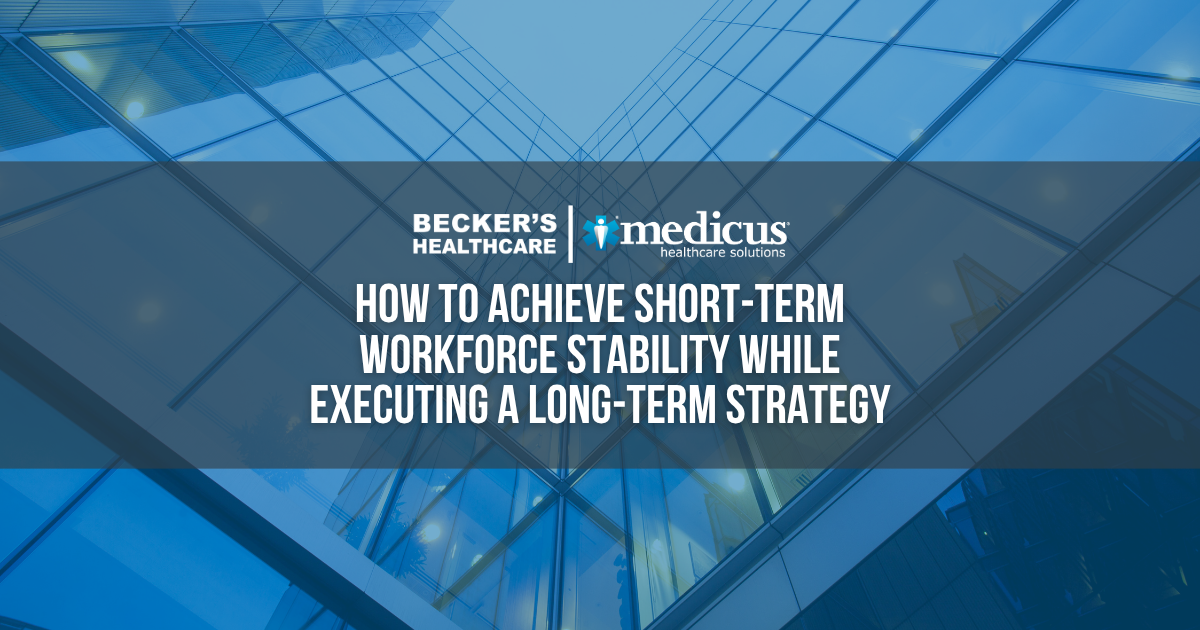Closing Provider Shortages: Lessons in Building a Sustainable Clinical Workforce

As health systems continue to face clinical workforce shortages, many leaders are looking for actionable strategies to build stronger, more resilient coverage models.
During a Becker’s Healthcare virtual event, Chad Tuttle, Chief Operating Officer at Corewell Health, and Dr. Robert Roose, President of Community Hospitals at Trinity Health New England, shared lessons from their health systems on building a more sustainable clinical workforce. Their perspectives offered insight into what they’ve learned over the past two years, the challenges they’ve encountered, and how their health systems have responded to support long-term coverage stability.
Identify Early Warning Signs Before They Disrupt Care
It's often only in hindsight that early signs of strain come into focus. Chad Tuttle refers to these moments as "weak signals": subtle shifts that indicate growing pressure on clinical teams, even if they are easy to overlook in the moment. At Corewell Health, these signals included slower read times in radiology and reduced call coverage in areas such as anesthesia.
"When we looked back, we realized those groups were starting to struggle, and we didn't know it at that time, and those struggles manifested themselves into bigger problems in terms of actual coverage," Chad Tuttle said.
Looking back on those experiences, Corewell Health has taken a more intentional approach to how it supports and engages with independent groups. This includes building clearer expectations into contracts and maintaining regular, structured conversations that create space for mutual awareness. These discussions often focus on staffing models and recruitment pipelines, as well as identifying areas where Corewell Health can provide additional support to ensure the groups succeed.
In situations where an independent group is not the right long-term fit, Corewell Health transitions that service line to an employed model. Chad Tuttle encourages other healthcare leaders to be prepared for that possibility. "One thing I wish we'd done is, when we suspected we might have to go to an employed model, having those plans in place, having that strategy and playbook ready to execute," Chad Tuttle explained. "You ought to have a contingency plan in the areas that you don't have employed models," so organizations can act quickly and ensure access to care without disruption.
Dr. Robert Roose of Trinity Health New England echoed this mindset, pointing out that the earliest signs of needed change often come from those closest to the bedside. "One of the top lessons for me would be to always, you know, listen to your providers and what they're telling you," Dr. Roose explained, "as Chad said, they're sending some of those signals."
By staying aligned with providers and remaining aware of weak signals, Dr. Roose noted, health systems can make more informed decisions in real-time. "That way, you can move out of that firefighting mentality to a fire prevention strategy and think ahead and plan for that goal forward."
Build Culture into Your Staffing Strategy
As clinical workforce shortages continue, leaders are beginning to view culture as a cornerstone of workforce stability. At Trinity Health New England, culture is built around engagement and open communication, giving physicians and advanced practitioners a consistent voice in organizational decision-making.
Dr. Roose described a model focused on listening, maintaining two-way communication, and using that feedback to evaluate what's working and anticipate future needs. These efforts are supported by changes in technology and workflows aimed at reducing administrative burden and building a more sustainable system.
At Corewell Health, understanding and addressing the challenges providers face is central to how culture is managed. Chad Tuttle shared that provider leaders and staff facilitate both engagement services and local group discussions to surface specific friction points and generate solutions. One such solution was the creation of an "inboxologist" role.
"We have actually deployed some APPs whose sole job is to manage provider inboxes," Chad explained. Many physicians were struggling with constant messages and the sense that they could never keep up. This initiative, driven by a focus on engagement and responsiveness, has had clear results: "What we've done is we really were able to be more timely in our responses to patients," he said, and "it's also freed our providers up."
For those looking to optimize clinical resources while building a supportive culture, Chad offered this advice: "You just have to be intentional about listening," he said. "Give your providers the opportunity to give you feedback, and then respond and show up for them."
Leverage Locum Tenens as a Bridge to Long-Term Staffing Stability
Balancing immediate coverage needs with long-term workforce planning is a familiar challenge for healthcare leaders. In the short term, many organizations turn to their internal providers or engage locum tenens clinicians to maintain access and minimize disruption. These measures often offer practical relief when internal resources are strained.
Chad Tuttle emphasized the importance of using these moments not only to stabilize operations but to prepare for the future. "In the longer term, I think folks need to take advantage of whatever time they have now to ensure that they get more robust plans in place, have playbooks with multiple plans in place," he explained.
A key part of that strategy involves building relationships with trusted interim healthcare staffing partners. "Medicus has been a great partner for us as we've navigated a couple of specific shortages and a couple of specialty practice areas," Tuttle added.
When incorporated into a structured workforce plan, locum tenens can do more than address urgent needs. Interim healthcare staffing partners, such as Medicus, offer a consistent pathway for short-term coverage while also supporting contingency planning for future disruptions. These partnerships create the space for health systems to focus on recruitment, restructure service lines, and make longer-term decisions without sacrificing immediate access to care.
Interested in learning more about interim healthcare staffing with Medicus? Complete the short form below to connect with a member of the Medicus team.


